Introduction

Woks have been a cornerstone of Asian cuisine for centuries, prized for their versatility and ability to create unique flavors. These bowl-shaped cooking vessels originated in China over 2,000 years ago and have since become an indispensable tool in kitchens worldwide. The wok’s distinctive shape allows for quick, high-heat cooking, making it perfect for stir-frying, deep-frying, steaming, and even smoking foods.
In recent years, there’s been a growing concern about the safety of cookware materials. Many home cooks are now seeking non-toxic alternatives to traditional non-stick pans, which often contain harmful chemicals. This shift has brought non-toxic woks into the spotlight, combining the classic cooking benefits of a used nonstick wok with the peace of mind that comes from using safer materials.
The importance of non-toxic cookware can’t be overstated. When exposed to high temperatures, some materials can release toxic fumes or leach harmful substances into food. This is particularly relevant for wok cooking, which often involves high heat and rapid temperature changes. By choosing a non-toxic wok, you’re not only investing in a versatile cooking tool but also prioritizing your health and the well-being of your family.
Woks are celebrated for their ability to cook food quickly and evenly, thanks to their unique shape and heat distribution properties. They excel at creating the coveted “wok hei” or “breath of the wok” – a smoky flavor that’s the hallmark of perfectly stir-fried dishes. Beyond stir fry-frying, woks are excellent for:
-
Deep-frying with less oil due to their sloped sides
-
Steaming when paired with a bamboo steamer
-
Smoking small quantities of food
-
Braising and making soups
As we delve deeper into the world of non-toxic woks, we’ll explore the best materials, top picks for 2024, and everything you need to know to choose and use the perfect wok for your kitchen. Whether you’re a seasoned chef or a curious beginner, this guide will help you navigate the options and find the best non-toxic wok to elevate your cooking.
For more information on the history and cultural significance of woks, check out this detailed article from The Woks of Life.
Understanding Non-Toxic Cookware
When we talk about “non-toxic” cookware, we’re referring to cooking vessels that don’t release harmful chemicals or substances into food during the cooking process. This is especially crucial for woks, which are often used at high temperatures that can cause less stable materials to break down.
What does “non-toxic” mean in cookware?
Non-toxic ceramic cookware that is made from materials that are stable at high temperatures and don’t react with food. These materials should not leach harmful substances into your meals, even when exposed to acidic ingredients or high heat. The concept of non-toxic cookware has gained traction as consumers become more aware of the potential health risks associated with certain types of pots and pans.
Common toxic materials to avoid
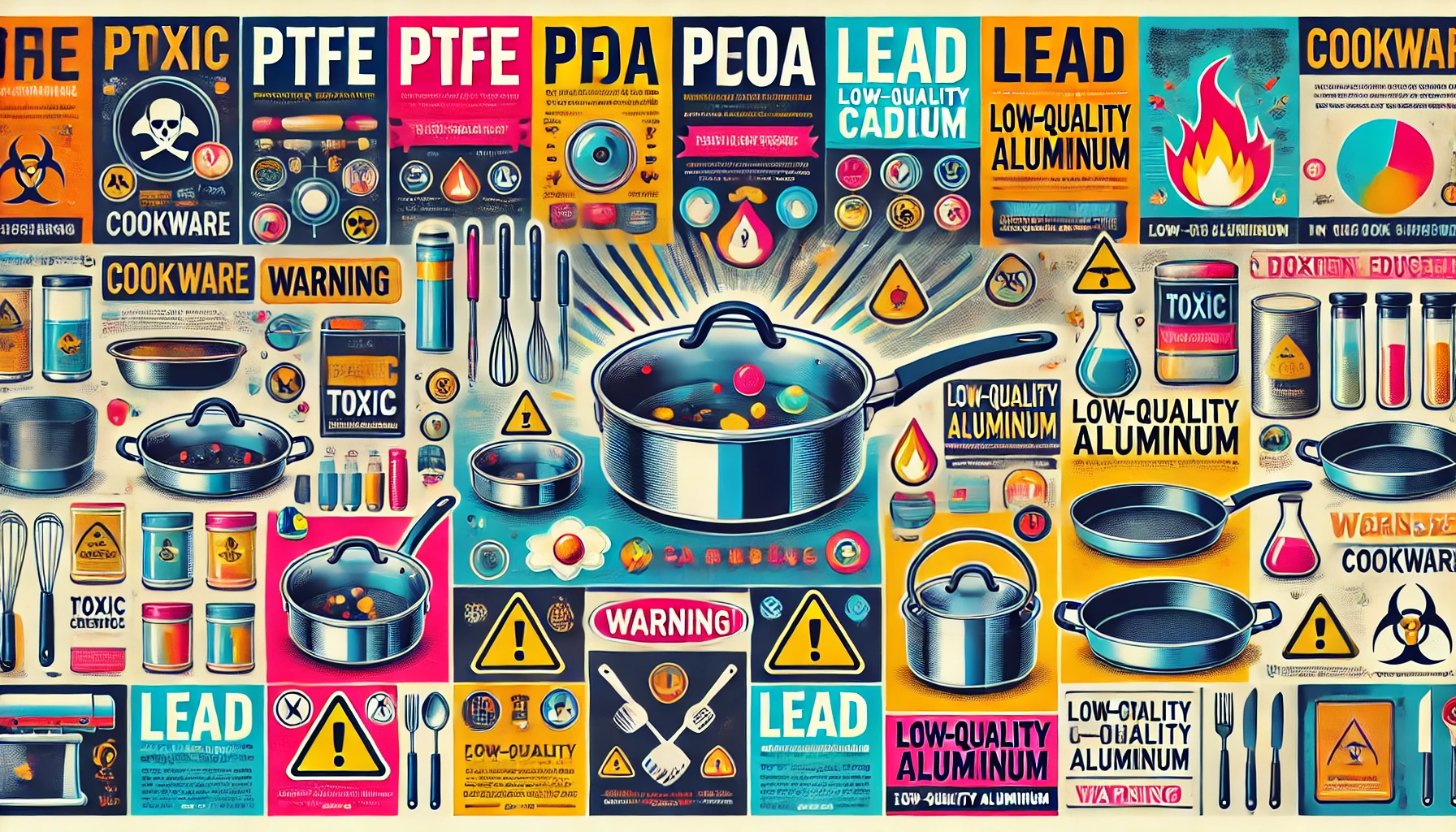
When shopping for a wok, it’s important to be aware of materials that may pose health risks:
-
PTFE (Polytetrafluoroethylene): Better known as Teflon, this non-stick coating can release toxic fumes when overheated (above 500°F or 260°C).
-
PFOA (Perfluorooctanoic acid): Previously used in the production of Teflon, this chemical has been linked to various health issues and is now banned in many countries.
-
Lead and Cadmium: Sometimes found in low-quality ceramic coatings, these heavy metals can leach into food and cause serious health problems.
-
Aluminum: While not toxic in small amounts, excessive aluminum exposure has been linked to health concerns. Some poorly made aluminum cookware can leach this metal into food, especially when cooking acidic dishes.
Benefits of using non-toxic woks
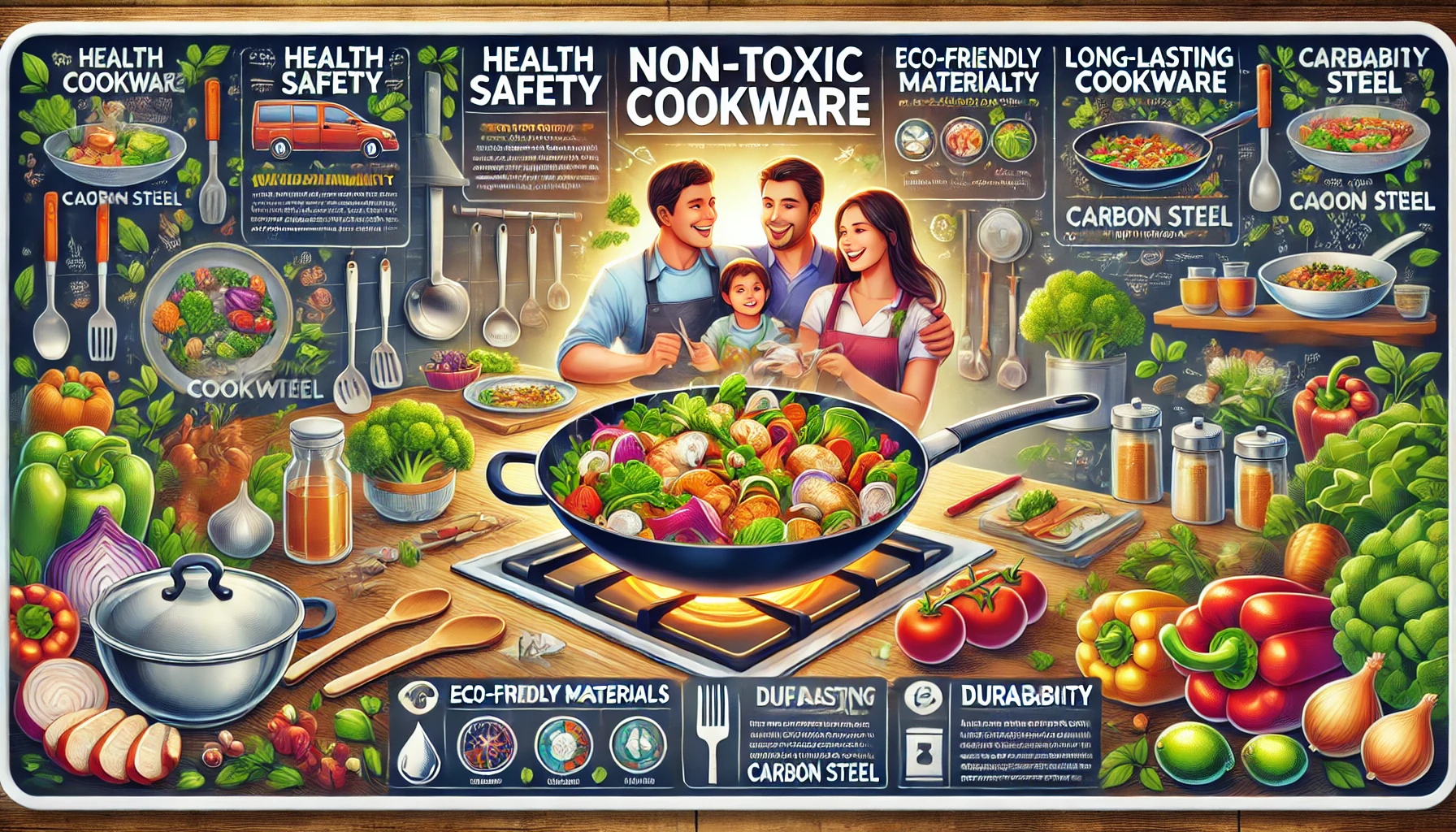
Opting for a non-toxic wok offers several advantages:
-
Health Safety: Reduces exposure to potentially harmful chemicals and metals, promoting overall well-being.
-
Durability: Many non-toxic materials, like carbon steel and cast iron, are extremely durable and can last for generations with proper care.
-
Versatility: Non-toxic woks can handle high heat cooking methods, making them ideal for achieving authentic wok hei.
-
Improved Flavor: Without chemical coatings, these woks allow for better flavor development in your dishes.
-
Environmental Friendliness: Many non-toxic materials are recyclable and have a lower environmental impact compared to non-stick coated alternatives.
For a deeper dive into the science behind cookware safety, the National Institutes of Health provides comprehensive research on the topic.
By choosing a non-toxic wok, you’re not just investing in a cooking utensil; you’re making a conscious decision to prioritize your health and the quality of your meals. As we explore different materials and options in the following sections, keep these principles in mind to find the best non-toxic wok for your kitchen.
Materials Used in Non-Toxic Woks
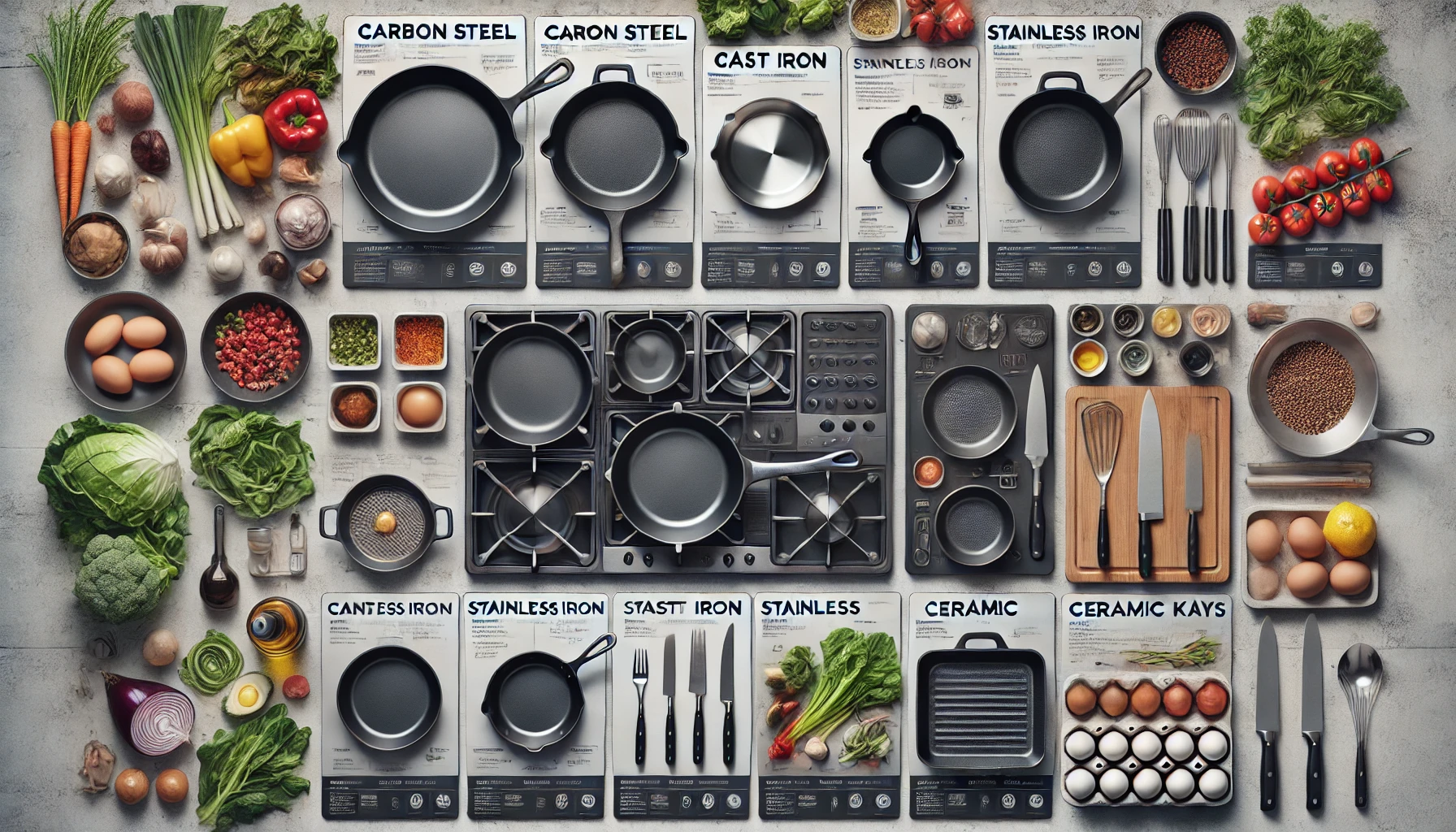
When it comes to non-toxic woks, several materials stand out for their safety, durability, and cooking performance. Let’s explore each option in detail:
Carbon Steel (Highly Recommended)
Carbon steel is often considered the gold standard for woks. Here’s why:
-
Heat Conductivity: Excellent heat distribution and responsiveness.
-
Durability: With proper care, can last for generations.
-
Seasoning: Develops a natural non-stick patina over time.
-
Lightweight: Easy to maneuver for stir-frying.
Pros:
-
Achieves high temperatures quickly
-
Develops wok hei flavor
-
Versatile for various cooking methods
Cons:
-
Requires seasoning and maintenance
-
Can rust if not properly cared for
For an in-depth guide on seasoning carbon steel woks, check out Serious Eats’ tutorial.
Cast Iron
Cast iron woks offer unique benefits:
-
Heat Retention: Holds heat exceptionally well.
-
Durability: Virtually indestructible with proper care.
-
Versatility: Great for stovetop and oven use.
Pros:
-
Excellent for slow-cooking and braising
-
Adds dietary iron to food
-
Develops a non-stick surface over time
Cons:
-
Heavy and difficult to maneuver
-
Slow to heat up and cool down
Stainless Steel
While not traditional, stainless steel woks have their place:
-
Non-Reactive: Safe for cooking acidic foods.
-
Easy Maintenance: Dishwasher safe and doesn’t require seasoning.
-
Durability: Resistant to scratches and dents.
Pros:
-
Low maintenance
-
Won’t rust or react with foods
-
Often oven-safe
Cons:
-
Doesn’t heat as evenly as carbon steel
-
Food may stick more easily
Ceramic
Ceramic woks are gaining popularity for their non-toxic properties:
-
Non-Stick: Many ceramic woks have a natural non-stick surface.
-
Even Heating: Distributes heat well.
-
Aesthetically Pleasing: Often comes in vibrant colors.
Pros:
-
Easy to clean
-
No seasoning required
-
Can be used with less oil
Cons:
-
May chip or crack if dropped
-
Not as durable as metal woks
Top Non-Toxic Wok Picks for 2024

After extensive research and testing, here are our top picks for non-toxic woks in 2024:
Best Overall: Yosukata Carbon Steel Wok
The Yosukata Carbon Steel Wok stands out for its traditional craftsmanship and excellent performance.
Key Features:
-
14-inch diameter
-
Pre-seasoned
-
Suitable for all stovetops
-
Wooden handle for comfortable grip
Why We Love It: This wok heats quickly and evenly, making it perfect for achieving that coveted wok hei flavor. Its pre-seasoned surface means you can start cooking right away, and with proper care, it will develop an even better non-stick patina over time.
Best Starter Set: Souped Up Recipes Carbon Steel Wok
For those new to wok cooking, this set provides everything you need to get started.
Key Features:
-
12.5-inch flat bottom wok
-
Comes with lid, spatula, and video tutorials
-
Pre-seasoned
-
Wooden handle
Why We Love It: This wok is not only high-quality but also comes with helpful accessories and resources for beginners. The flat bottom makes it suitable for all stovetops, including electric and induction.
Best Nonstick Alternative: Circulon SteelShield Wok
For those who prefer a non-stick surface without the health concerns of traditional coatings:
Key Features:
-
14-inch diameter
-
PFOA-free non-stick surface
-
Stainless steel base for durability
-
Oven safe up to 500°F
Why We Love It: This wok combines the durability of stainless steel with a safer non-stick coating, making it a great option for those who want easy food release without the need for seasoning.
Check price on Circulon’s website
Best Splurge: Mammafong Blue Carbon Steel Wok
For the serious home chef looking for a premium wok:
Key Features:
-
14-inch diameter
-
Hand-hammered blue carbon steel
-
Wooden handle and helper handle
-
Comes with a lid
Why We Love It: The hand-hammered surface of this wok creates micro-textures that enhance non-stick properties and contribute to better wok hei. Its craftsmanship and attention to detail justify the higher price point.
Check price on Mammafong’s website
Best Budget: T-fal Jumbo Wok
For those on a tight budget who still want a reliable non-toxic option:
Key Features:
-
14-inch diameter
-
Aluminum core with ceramic coating
-
PTFE, PFOA, and Cadmium free
-
Dishwasher safe
Why We Love It: This wok offers good performance at an affordable price. The ceramic coating provides non-stick properties without harmful chemicals, making it a safe choice for budget-conscious cooks.
Factors to Consider When Choosing a Non-Toxic Wok
When selecting the best non-toxic wok for your kitchen, consider the following factors:
Size and Shape
-
Size: Woks typically range from 12 to 16 inches in diameter. A 14-inch wok is versatile for most home cooking needs.
-
Shape:
-
Round bottom: Traditional, best for gas stoves
-
Flat bottom: Better for electric and induction cooktops
-
Handle Type and Material
-
Long handle: Offers better control for tossing and stir-frying
-
Loop handles: Easier for transferring heavy dishes
-
Material: Wood stays cool but isn’t oven-safe; metal can get hot but is more durable
Compatibility with Your Stovetop
-
Gas stoves work well with both round and flat-bottom woks
-
Electric and induction cooktops require flat-bottom woks
-
Consider a wok ring for better stability on gas stoves
Weight and Maneuverability
-
Lighter woks are easier to lift and toss
-
Heavier woks retain heat better but can be challenging to maneuver
Price and Warranty
-
Quality woks can range from $30 to $200+
-
Look for woks with warranties against defects
Heating Capacity
-
Choose woks that can withstand high temperatures (up to 500°F or more)
-
Carbon steel and cast iron excel in high-heat cooking
Maintenance Requirements
-
Consider how much time you’re willing to spend on seasoning and care
-
Stainless steel and ceramic require less maintenance than carbon steel and cast iron
How Woks Were Tested
To ensure our recommendations are reliable, we put each wok through a series of tests:
-
Seasoning Process: We evaluated the ease of initial seasoning for carbon steel and cast iron woks.
-
Heat Distribution: Using an infrared thermometer, we measured heat distribution across the wok surface.
-
Cooking Performance: We tested each wok by:
-
Stir-frying vegetables to assess heat retention and distribution
-
Cooking fried rice to test non-stick properties
-
Searing meat to evaluate high-heat performance
-
-
Ease of Cleaning: We assessed how easily food residue could be removed and how well the wok maintained its seasoning or non-stick properties after cleaning.
-
Durability: We subjected each wok to simulated long-term use, including repeated heating and cooling cycles.
How to Season and Maintain Your Non-Toxic Wok
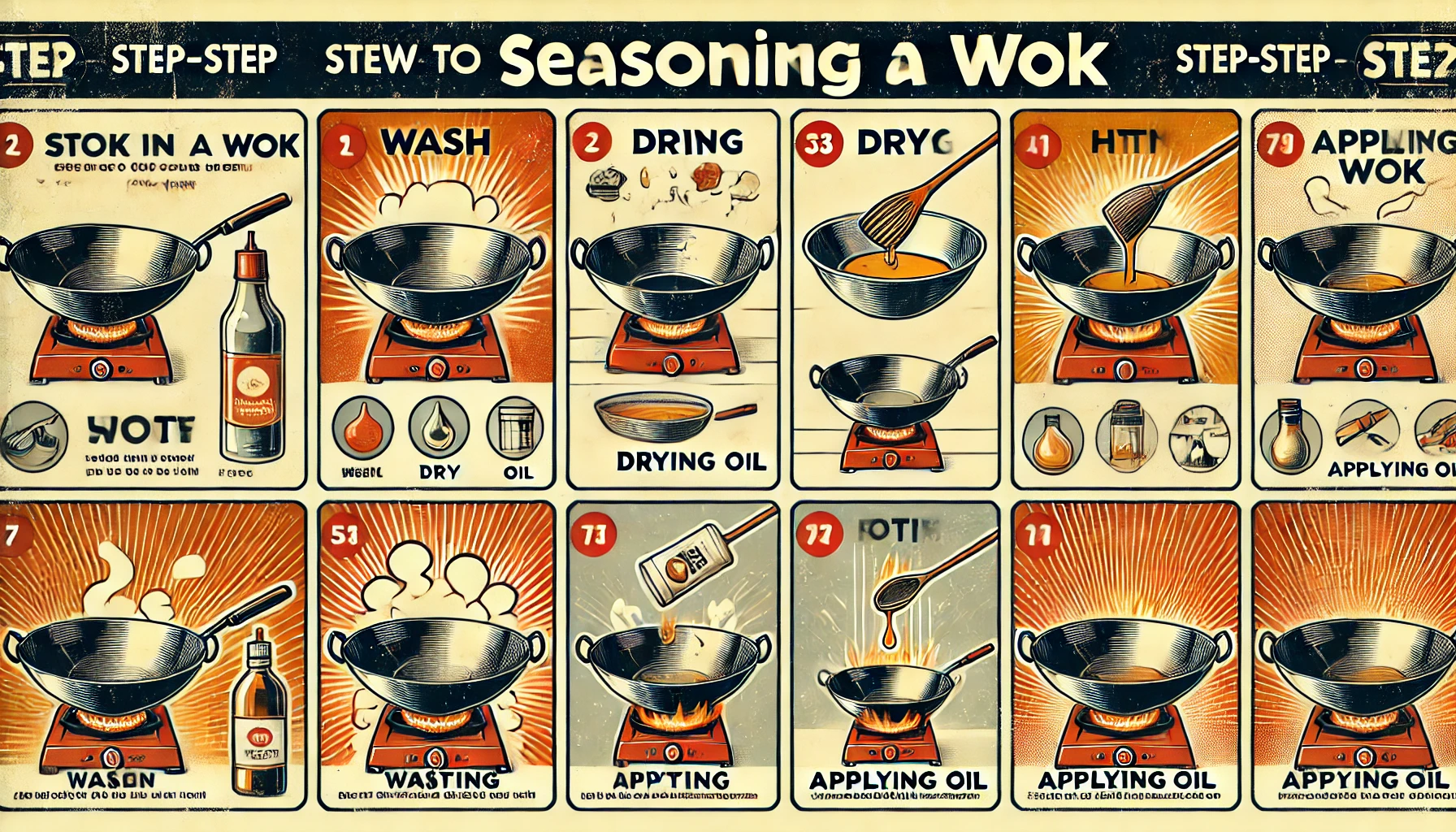
Proper seasoning and maintenance are crucial for the longevity and performance of your wok, especially for carbon steel and cast iron varieties.
Seasoning Process
-
Wash the wok with hot water and mild soap to remove any manufacturing residue.
-
Dry thoroughly and place on high heat until it starts to smoke.
-
Add a thin layer of oil (flaxseed or grapeseed oil work well) and spread it evenly with a paper towel.
-
Heat the oiled wok until it smokes, then let it cool.
-
Repeat the oiling and heating process 2-3 times for a good initial seasoning.
For a visual guide on seasoning, check out this YouTube tutorial.
Cleaning Tips
-
Avoid soap on seasoned carbon steel or cast iron woks; use hot water and a soft brush instead.
-
Dry immediately after washing to prevent rust.
-
Apply a thin layer of oil after each use to maintain the seasoning.
Storage Recommendations
-
Store in a dry place to prevent rust.
-
If stacking, place a paper towel between woks to prevent scratches.
Signs It’s Time to Replace Your Wok
-
Deep scratches or chips in the cooking surface
-
Warping that affects cooking performance
-
Persistent rust that doesn’t improve with re-seasoning
Cooking with Your Non-Toxic Wok

A well-chosen non-toxic wok opens up a world of culinary possibilities. Here are some tips to make the most of your wok:
Best Dishes to Cook in a Wok
-
Stir-fries: The classic wok dish, perfect for quick-cooking vegetables and meats.
-
Fried Rice: Utilize the high sides to toss ingredients without spilling.
-
Deep-frying: The wok’s shape allows for efficient use of oil.
-
Steaming: Pair with a bamboo steamer for dumplings or fish.
-
Smoking: Use wood chips in the bottom of the wok to impart smoky flavors.
Tips for Achieving Wok Hei
Wok hei, or the “breath of the wok,” is that coveted smoky flavor in Chinese cuisine. Here’s how to achieve it:
-
Preheat your wok until it’s smoking hot.
-
Use high heat throughout the cooking process.
-
Cook in small batches to maintain high temperature.
-
Keep ingredients moving constantly.
-
Master the art of tossing food in the wok.
For more on wok hei, read this Serious Eats article.
typically faster than other methods.
– Be mindful of oil smoking points when cooking at high temperatures.
Health Benefits of Cooking with a Non-Toxic Wok
Using a non-toxic wok not only enhances your culinary experience but also offers several health benefits:
-
Reduced Exposure to Harmful Chemicals: Non-toxic woks eliminate the risk of ingesting PFOA, PTFE, and other potentially harmful substances found in some non-stick coatings.
-
Potential for Using Less Oil: The high heat and quick cooking time of wok cooking often require less oil than other methods, promoting healthier eating.
-
Retention of Nutrients: Quick cooking at high temperatures helps preserve vitamins and minerals in vegetables that might be lost with longer cooking methods.
-
Iron Fortification: When using a cast iron skillet or carbon steel woks, a small amount of iron can leach into your food, which can be beneficial, especially for those with iron deficiencies.
-
Encourages Healthy Cooking Methods: Wok cooking naturally lends itself to methods like stir-frying and steaming, which are healthier alternatives to deep-frying or heavy sauces.
Environmental Impact of Non-Toxic Woks
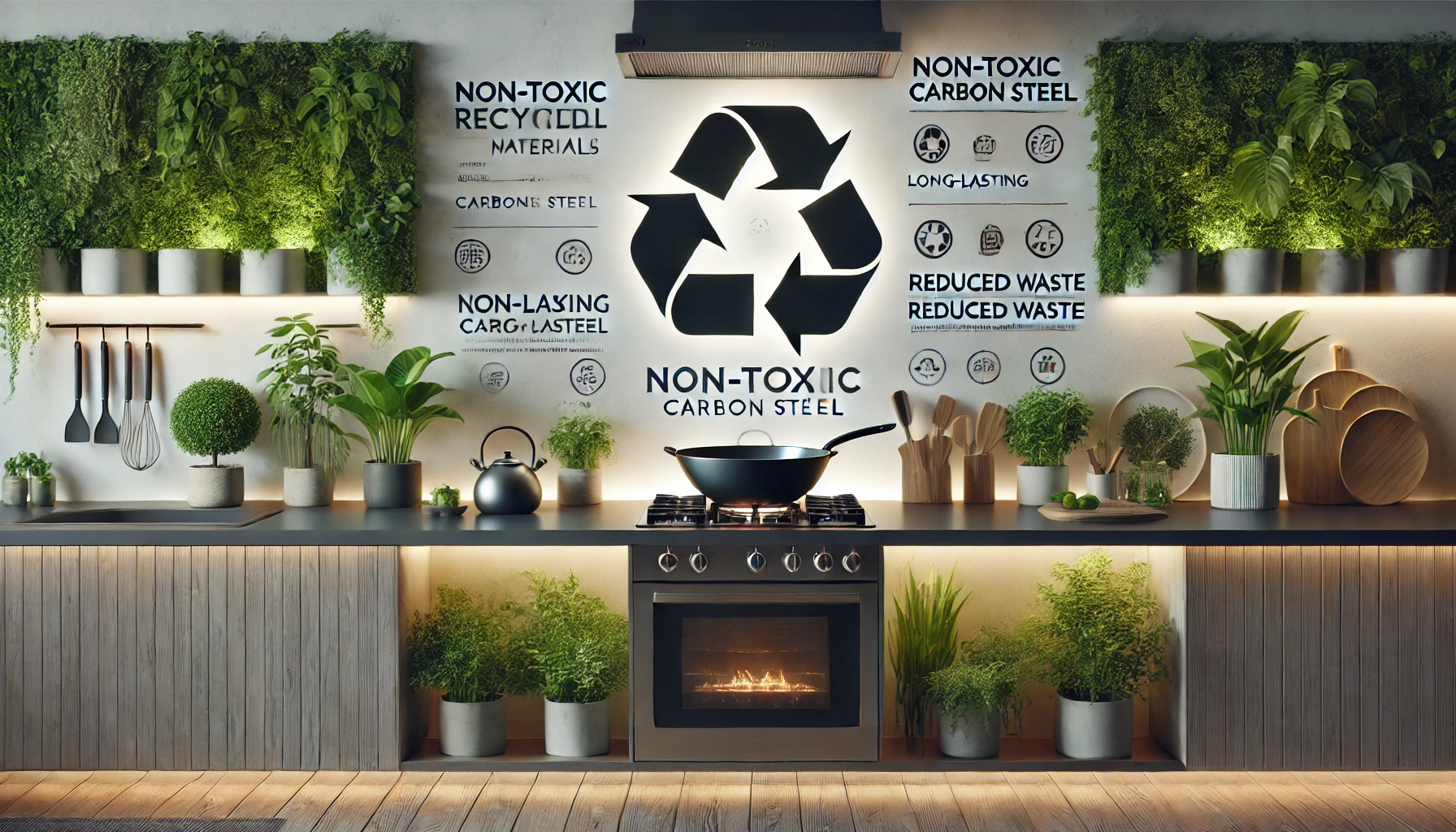
Choosing a non-toxic wok can also have positive environmental implications:
-
Sustainability of Materials: Materials like carbon steel and cast iron are highly durable and can last for generations with proper care.
-
Longevity Compared to Non-Stick Alternatives: Traditional non-stick pans often need replacement every few years, while a well-maintained nonstick surface less-toxic wok can last a lifetime.
-
Recyclability: At the end of their (very long) life, materials like carbon steel and cast iron are fully recyclable.
-
Energy Efficiency: The high heat conductivity of materials like carbon steel can lead to more efficient cooking, potentially saving energy over time.
-
Reduced Chemical Production: By avoiding PTFE and other chemical coatings, the production of these woks involves fewer harmful substances.
For more on sustainable and safe cookware choices, visit the Environmental Working Group’s guide.
Essential Wok Accessories

To make the most of your non-toxic wok, consider these essential accessories:
-
Wok Spatula: A long-handled metal spatula designed for stir-frying.
-
Spider Strainer: Perfect for removing food from oil when deep-frying.
-
Dome Lid: Useful for steaming and simmering.
-
Bamboo Brushes: For cleaning without damaging the seasoning.
-
Wok Ring: Provides stability for round-bottom woks on flat stovetops.
FAQs About Non-Toxic Woks
-
Are all stainless steel woks non-toxic?
Generally, yes. High-quality stainless steel is considered non-toxic and safe for cooking.
-
Can I use metal utensils with my non-toxic wok?
For carbon steel and cast iron woks, yes. Be gentler with ceramic-coated woks to avoid scratching.
-
How often should I season my carbon steel or cast iron wok?
Re-season when you notice food starting to stick or the surface looking dry or patchy.
-
Are non-toxic woks suitable for induction cooktops?
Flat-bottom carbon steel and some stainless steel woks work well on induction. Always check the manufacturer’s specifications.
-
Can I put my non-toxic wok in the dishwasher?
It’s not recommended for carbon steel or cast iron woks. Some stainless steel and ceramic-coated woks may be dishwasher safe.
-
What’s the best wok for different stove types?
-
Gas: Round or flat-bottom woks
-
Electric: Flat-bottom woks
-
Induction: Flat-bottom carbon steel or magnetic stainless steel woks
-
-
How do I achieve wok hei flavor?
Use high heat, preheat your wok well, and cook in small batches to maintain temperature.
-
Do I need a wok ring?
A wok ring is useful for round-bottom woks on flat stovetops or for added stability.
Conclusion

Choosing the best non-toxic wok is an investment in both your culinary adventures and your health. By opting for materials like carbon steel, cast iron, or high-quality stainless steel, you’re ensuring that your cooking is not only delicious but also free from potentially harmful or toxic chemicals too.
Remember, the key factors in selecting your wok are:
-
Material safety and performance
-
Compatibility with your cooking style and stovetop
-
Willingness to maintain and season your wok
Our top recommendation, the Yosukata Carbon Steel Wok, offers an excellent balance of traditional craftsmanship, performance, and safety. However, each of our picks has its strengths, and the best choice for you will depend on your specific needs and preferences.
Investing in a high-quality, non-toxic wok is more than just buying a kitchen tool – it’s embracing a healthier, more versatile way of cooking. With proper care, your wok can become a beloved kitchen companion for years to come, helping you create delicious, nutritious meals while minimizing exposure to harmful chemicals.
Whether you’re a seasoned chef or just starting your culinary journey, a non-toxic wok is a fantastic addition to your kitchen arsenal. So grab your wok, fire up the stove, and get ready to explore a world of flavors – all while keeping your health and the environment in mind. Happy cooking!
